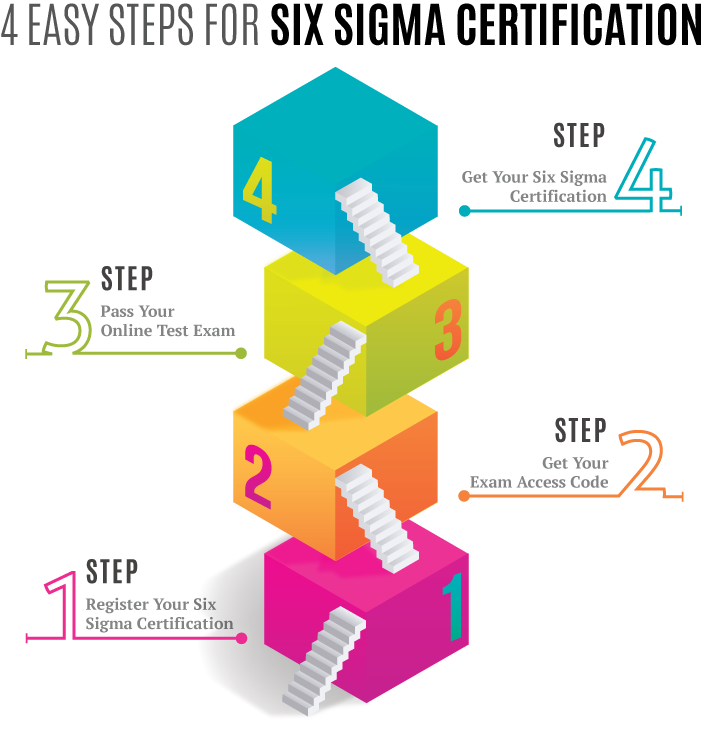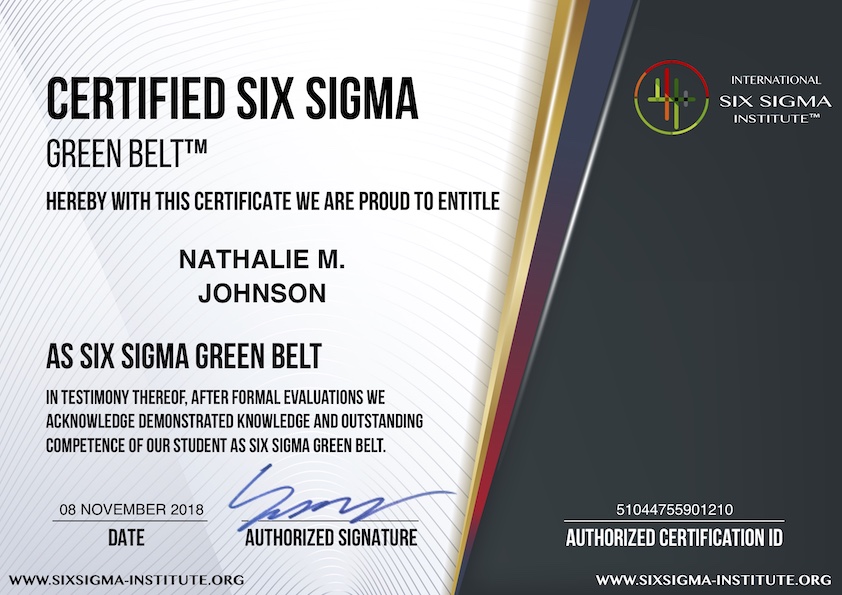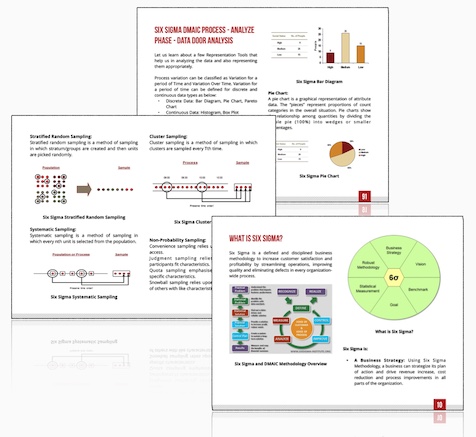Voice of Customer (VOC) in Six Sigma
Turning Customer Feedback Into Process Improvement
The Voice of Customer process in Six Sigma helps you listen to your customers. It turns their needs and wants into clear steps for making your product or service better. Customers are happy when what they get matches what they wished for, much like finding that the juice from a freshly-peeled orange is sweet and not sour. So, by using the Voice of Customer process, you can make sure what you give them is what they really want - and that brings them back for more. It's time to lend an ear to those voices.
In Six Sigma, the voice of the customer is integrated through methods such as surveys, interviews, and observations to capture customer needs and translate them into product or service requirements. This ensures that processes are aligned with customer expectations and leads to continuous improvement in quality and efficiency.
What is Voice of Customer (VOC)?
Voice of Customer is the customer’s voice, expectations, preferences, comments, of a product or service in discussion. It is the statement made by the customer on a particular product or service.
Customer Identification:
Customer is the one who buys or uses your products/services and he/she is the one who receives the process output. We broadly classify customers into two categories:
- Internal Customers: Internal Customers are the ones who are internal to the organization. They are Management, Employee(s) or Any Functional Department in your organization.
- External Customers: External Customers are not a part of the organization. They are either the ones who use our product(s) or service(s) or have vested interest in the organization. For e.g. Clients, End-Customers, Shareholders, among others.
Customer Needs and Requirements
Need is a desire or an expectation of a customer from a given product or service. Customers may have many stated needs which are often vague and generally are “wants” from a product/service.
For example Customer requires an Air-Conditioner for its use in his/her bed-room. The real need of the customer is cool temperature in the bedroom. Similarly, the real want from the Air-Conditioner is it has to be quite, cost-effective and maintenance free. When the customer states his/her requirements, we will often get to hear that the need is “Cool Temperature, Less Noise (quite), Cost Effective and Free of Maintenance”. However, “Cool Temperature” is the need and the rest are just wants. It is important for the project team to understand the stated needs of the customer and separate them from wants.
The main reason that we separate needs and wants are: Needs are important critical features and Wants are expectations of the product or service over and beyond the needs. If the product/service is not able to fulfill “Wants” of the customer, the customer may only be highly displeased / dissatisfied. However, if the product/service is not able to fulfill “Needs” of the customer, he/she will not use the product/service and there is a high likelihood that he/she will switch to competitors product/service. Organizations reputation may also be at stake if “Needs” are not met.
Requirement is an attribute of the product or service which fulfils the needs of a customer. Customer defines these requirements and are the “musts” of a product or service.
For example in the above example of an air-conditioner, customer’s requirement is “Cool Temperature” and the rest are “Good to Have” features. Customer will not buy the Air-Conditioner if all of “Good to Have” features are present but the “Requirement(s)” are not fulfilled. However, customer may buy the product/service if the “Requirement” is fulfilled and “Good to Have” features are present or not present.
Translating Voices to Needs
Voice of Customer (VOC) methodology can be used to capture the customer needs – both current (stated needs) and latent (unstated needs). VOC methodology helps capture the needs of customer through stated verbatim comments (customer voices). It helps translate verbatim comments (customer voices) into customer needs to product/service output characteristics (customer requirements).
Distinct Categories of VOC
At an organization level we broadly classify VOC into four distinct categories (AICP):
- Voice of Associate: The feedback that we get from our Employees
- Voice of Investor: The feedback that we get from our Management and Shareholders
- Voice of Customer: The feedback that we get from our Clients and End-customers
- Voice of Process: The feedback that we get from measuring our CTPs (Critical To Process) and CTQs (Critical To Quality)

Six Sigma - Voice of AICP (Associate, Customer, Investor and Process)
Voice of Customer (VOC) Methods
- Surveys: Surveys are a designed set of questionnaire which is sent out to potential or existing customers. Surveys are cost effective, however, have very low response rate.
- Interviews: Interviews are individual meetings with potential or existing customers where a set of questions are asked and answers are discussed to understand customer voices. Interviews can tackle Complex Issues, however, requires Trained Resources.
- Focus Group: A group of people are called together in one conference room and a discussion is held on specific topics that need to be addressed. These focus groups are excellent for identifying the CTQ (Critical to Quality), however, are difficult to generalize.
- Suggestions: Client/Customer/Employee feedback is received and treated as suggestion to improve product or service. Suggestions provide good improvement opportunities, however, does not look at overall process.
- Observations: During the course of the process, individuals can have observations and can provide feedback to the process which does act as a Voice of Customer.
Below is a sample of Voice of Customer that is translated into a Requirement:
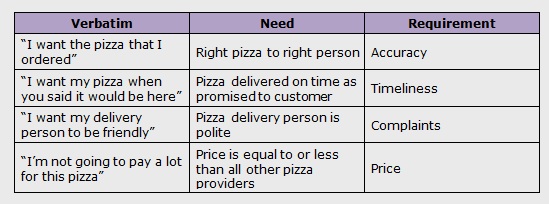
Six Sigma - Translating Voice of Customer into Requirements
Voice of Customer (VOC) in Six Sigma
In the world of Six Sigma, the Voice of the Customer (VOC) is a vital link between customers' needs and the organization's processes. It's like a compass guiding businesses to sail in the right direction by aligning their efforts with what truly matters to their customers. Understanding VOC ensures that the end product or service is not only successful but also well-received by the target audience.
So, what exactly is this "Voice of the Customer" all about? It’s more than just listening to what they say; it’s about interpreting their needs and then acting upon those insights. The goal here is to capture, analyze, and translate customer feedback into executable requirements that cater to their desires and expectations.
Let's take an example. If you run a coffee shop and notice that your regulars often complain about long wait times, that's an indication that you're not meeting their expectation for quick service. By recognizing this, you can implement changes to speed up your service process, ensuring your customers leave happy and satisfied.
This approach does not solely benefit businesses; it also enhances customer satisfaction and loyalty. Consider a scenario where a company incorporates customer feedback into product design. The result is a product that better aligns with what customers want, fostering a stronger bond between customers and the brand.
The relevance of VOC in Six Sigma extends beyond just improving products or services; it extends to refining internal processes within the organization. By embedding VOC into process improvement initiatives, businesses can identify areas that directly impact customer experience and tailor those areas to meet customer needs effectively.
Now that we have a good understanding of what VOC entails in the Six Sigma context and how it benefits both businesses and customers, let's explore how organizations can effectively implement VOC methodologies to drive sustained improvements.
Having grasped the concept of harnessing customer feedback for process improvement, it's imperative to delve into the key components that make up an effective Voice of Customer strategy.
Key Voice of Customer (VOC) Components
In Six Sigma process, customer feedback serves as the compass guiding process improvement. The Voice of Customer (VOC) is instrumental in shaping the direction of quality initiatives with its multifaceted approach. Let's examine how each step contributes to capturing and translating the customer's voice into actionable insights for process enhancement.
Customer Data Collection
The first component centers on systematic data collection, drawing from various sources such as surveys, interviews, focus groups, observations, and suggestions. Each method provides a unique perspective on customer needs and preferences, adding layers to the comprehensive picture of end-user expectations.
Surveys are particularly valuable for their efficiency in gathering large-scale feedback, but they often suffer from low response rates. On the other hand, interviews offer a deeper understanding of complex issues but can be resource-intensive. Focus groups shine in identifying critical quality factors through group discussions but may pose challenges in generalizing findings. Observations provide real-time insight into customer behavior but may lack context without accompanying qualitative input.
The blend of these methodologies presents a rich tapestry of customer preferences and pain points, allowing organizations to construct a vivid representation of their target audience's demands.
Identifying Critical Factors
Having amassed a wealth of customer feedback, distilling this data is crucial to isolating critical quality factors. By sifting through the accumulated feedback, organizations can pinpoint aspects that hold utmost importance to customers, prioritizing these areas for improvement efforts.
This emphasis on identifying key factors ensures that resources are directed towards addressing issues that carry significant weight in shaping the overall customer experience. For instance, if customers consistently highlight reliability as a pivotal concern in product performance, focusing on enhancing product durability and robustness becomes paramount.
Creating Actionable Requirements
The final component involves translating qualitative customer feedback into tangible, measurable requirements that form the bedrock for refining existing products or services and creating new ones aligned with customer expectations.
This shift from qualitative feedback to actionable requirements lays the groundwork for tangible process improvements and new product development initiatives. By bridging the gap between subjective feedback and quantifiable requirements, organizations can systematically embark on initiatives aimed at aligning offerings with customer expectations.
In essence, these three components intertwine to harness the boundless potential of customer feedback – from its raw form as unstructured information to refined and actionable insights that drive continuous improvement efforts.
With an understanding of how customer feedback shapes process improvement efforts, let's now explore how to establish a continuous cycle for collecting and leveraging the Voice of Customer insights in "Building a VOC Feedback Loop.
Building a Voice of Customer (VOC) Feedback Loop
Capturing and understanding customer data is crucial for any organization seeking to continuously improve its processes. The first step in building a Voice of Customer (VOC) feedback loop is to gather detailed data from various customer touchpoints, such as surveys, interviews, and customer interaction channels. These touchpoints serve as valuable sources of information, providing direct insights into the needs, expectations, and preferences of the customers.
Consider this as an investigative process, much like collecting evidence at a crime scene. Each piece of data is a clue that can lead to valuable insights when pieced together. Surveys give structured responses, while interviews provide deeper, more personal perspectives—both essential for capturing the diverse range of customer sentiments and experiences. Moreover, feedback from customer interaction channels, such as social media platforms and direct customer support channels, serves as real-time data instrumental in understanding current issues or trends.
Imagine a company receiving feedback through a survey indicated that customers found their service response time too long. However, on further investigation through interviews and customer interaction channels, they found that customers were particularly frustrated due to the lack of personalized support during high-traffic hours. This realization could potentially lead to implementing a more efficient call-routing system during peak hours to provide personalized attention where it's needed the most.
Once all this data has been collected, it's important to organize and analyze it effectively.
Let's break down how organizing and analyzing the data plays a pivotal role in extracting actionable insights from the raw information gathered.
Organize and Analyze Data
Capturing large volumes of data isn't enough—it must be structured and analyzed effectively to derive meaningful conclusions. By organizing and categorizing the data, recurring themes and patterns representing the collective voice of the customer start to emerge. This allows for informed decision-making based on concrete evidence rather than assumptions or guesswork.
Picture this process as assembling a puzzle—each piece represents a different aspect of customer feedback. As these pieces are put together and patterns emerge, valuable insights are revealed. Categorizing data by aspects like product quality, service responsiveness, or user experience can highlight specific areas that require attention, thus providing clear direction for improvement efforts.
For instance, after organizing and analyzing customer data related to an e-commerce platform, it might become evident that a specific feature causes confusion among users. This insight could prompt the development team to prioritize simplifying or repositioning the feature for better usability, directly addressing a pain point expressed by customers.
With organized and analyzed data at hand, it's crucial to implement an effective feedback mechanism that integrates this valuable input into everyday operations.
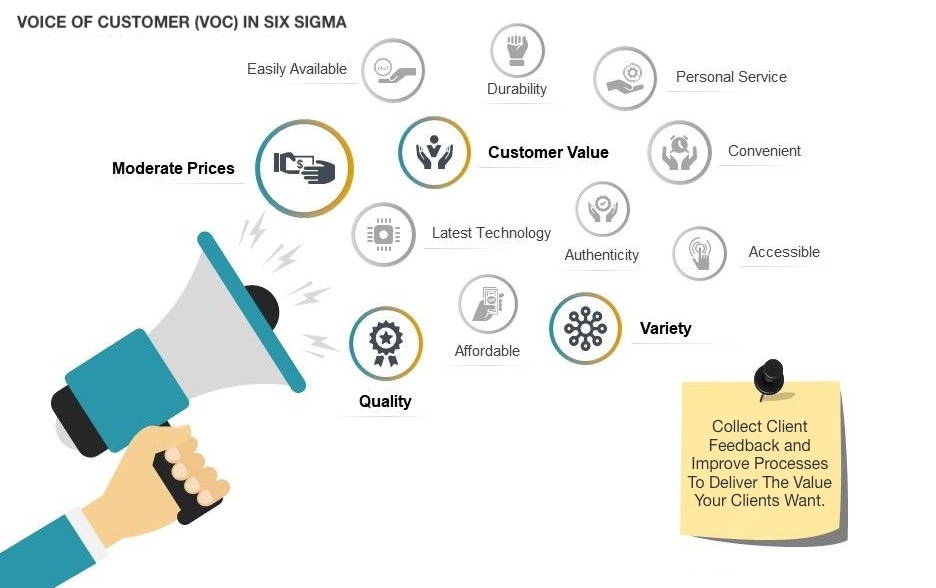
Voice of Customer in Six Sigma to Increase Customer Satisfaction and Improve Processes
Implement Feedback Mechanism
Establishing a robust system to integrate customer feedback into design, development, and improvement processes is imperative for ensuring that incoming VOC data drives meaningful changes. This strategy involves embedding mechanisms to capture ongoing feedback and utilizing it as a catalyst for continuous improvement.
Think of this as setting up traffic signals on your road to success—feedback goes both ways! Customers are constantly providing information while using your products or services; creating an efficient mechanism ensures you're not only capturing this vital input but also translating it into tangible improvements swiftly.
A software company implements an efficient feedback mechanism by integrating a user-friendly tool within their application interface. This allows users to report issues or suggest enhancements seamlessly. Their development team then reviews this feedback regularly, often resulting in timely bug fixes and feature updates driven by direct user input.
Building an effective VOC feedback loop isn't just about gathering information; it's about using that information in meaningful ways that drive tangible improvements—all with the ultimate goal of delivering what customers truly need and desire.
Analysis and Implementation of Feedback
Data is just data until you make sense of it and then use it to make a difference. That's what we are going to focus on as we talk about how to analyze and implement the valuable feedback gathered from our customers in Six Sigma.
Data Analysis
When you've collected all the feedback from your customers, it's time to roll up your sleeves and dive into the numbers. Utilize statistical methods and tools to put a spotlight on what your customers are telling you. By analyzing VOC data, you can uncover trends, common pain points, and areas for improvement.
One way of doing this is by looking at different types of data analysis methods such as regression analysis or Pareto charts. These will help you identify which issues are most critical to your customers and therefore need immediate attention.
Remember: the better you understand the data, the better you can serve your customers' needs. Understanding what your customers actually want gives you an edge in delivering quality products and services.
Translate Data into Action
Once you've crunched the numbers and identified key areas for improvement, the next step is perhaps even more crucial—translating these insights into action. It's all very well identifying pain points if you don't do anything about them! This involves taking the insights derived from customer feedback and transforming them into actionable plans and changes.
This isn't just about making superficial changes – it's about integrating them across departments to drive customer-centric enhancements in products and services. It's about creating a culture of continuous improvement where every voice is heard and valued; where every bit of feedback translates into a tangible enhancement.
Remember: Implementation is where change happens.
Let’s say one common feedback from customers is that they find it difficult to navigate through your app to find relevant information. Instead of merely acknowledging this observation, translate this insight into action by redesigning the user interface or providing additional search features. This shows that you're not just listening; you’re acting on what you hear.
As we wrap up our discussions on this topic, remember that while gathering customer feedback is important, understanding and implementing that feedback holds the power to transform your business operations for the better.
Essential Tools for Voice of Customer (VOC) Implementation
When it comes to harnessing customer feedback for process improvement, several essential tools can provide valuable insights and perspectives. Let's take a closer look at some of these tools and how they can be effectively utilized.
Surveys
Surveys are a widely used and cost-effective method for gathering customer feedback at scale. By designing well-crafted surveys, organizations can extract valuable insights into customer needs, satisfaction levels, and expectations. The key to an effective survey lies in the formulation of precise questions that explore specific aspects of the customer experience. Whether it's about product functionality, service quality, or overall satisfaction, surveys offer a quantitative approach to understanding customer sentiments.
Pro Tip: Utilize open-ended questions in surveys to allow customers to express their thoughts freely. This can provide unfiltered qualitative insights alongside the quantitative data.
Customer Interviews
While surveys provide quantitative data, individual customer interviews offer qualitative insights that uncover underlying needs and expectations. Conducting in-depth interviews with a select group of customers can delve into their perceptions, preferences, and experiences in greater detail. These interviews can unearth specific pain points or areas for improvement and reveal nuanced aspects that may not surface through standard survey responses.
Expert Advice: Utilize open-ended questions during interviews to encourage customers to share detailed narratives about their experiences and desires. This helps capture nuanced insights that could drive impactful process improvements.
Focus Groups
Gathering small groups of customers in focus groups can facilitate insightful discussions on product/service experiences and requirements. Unlike surveys and individual interviews, focus groups enable customers to engage in interactive conversations and express collective sentiments. This approach helps uncover shared priorities, common pain points, and collective desires, providing a holistic view of customer needs.
Industry Insight: Focus groups present an opportunity for participants to react to each other's perspectives, leading to new insights and group dynamics that may not be apparent through other forms of feedback collection.
By leveraging these essential tools for VOC implementation, organizations can gain comprehensive insights into customer needs and expectations, paving the way for targeted process improvement initiatives. Each tool offers distinct advantages in collecting feedback, be it quantitative data from surveys or qualitative narratives from in-depth interviews and focus groups.
Now equipped with a clearer understanding of how to gather customer feedback effectively through various tools, let's delve into the role of VOC in structuring Six Sigma teams.
The Role of Voice of Customer (VOC) in Six Sigma Team Structure
When it comes to ensuring the success of a Six Sigma project, integrating the Voice of Customer (VOC) within the team structure plays a pivotal role in maintaining a customer-focused approach. Here's how VOC influences the team structure.
Customer-Centric Mindset: By integrating VOC within the Six Sigma team structure, there is a conscious effort to cultivate a customer-centric mindset. This means that every decision and improvement made by the team is aligned with the customer's perspective.
When teams are encouraged to think from a customer's point of view, they are more likely to identify critical quality factors that directly influence customer satisfaction. For example, if a certain process within an organization doesn't directly contribute to enhancing product quality or delivering better service to customers, then it might be deemed a lower priority. This change in perspective fosters a deeper understanding of customer needs and drives the team to innovate better solutions based on these needs.
Cross-Functional Collaboration
Apart from instilling a customer-centric mindset, VOC also encourages cross-functional collaboration. In traditional organizational structures, departments often operate independently of one another, leading to siloed decision-making processes that may not encompass the overall customer experience.
Consider this scenario: A customer submits feedback about a particular product feature that needs improvement. By incorporating this information into the project workflow, various departments such as product development, marketing, and manufacturing can collaboratively assess and address the issue.
This collaborative effort ensures that customer feedback significantly influences operational decisions, improvements, and product development. For instance, input gathered from customer interactions could prompt changes in product design or enhancement in service delivery processes. This cross-functional collaboration not only reflects a more cohesive approach but also ensures that all aspects of an organization are striving toward fulfilling the evolving needs of their customers.
The integration of VOC within the Six Sigma team structure not only fosters a customer-centric culture but also drives cross-functional collaboration, aligning internal efforts with external feedback for comprehensive process improvement.
In essence, harnessing the voice of the customer in Six Sigma methodologies empowers organizations to create a unified, responsive environment where every decision and improvement is driven by the evolving needs and expectations of their customers. This intrinsic alignment ensures sustained success and customer satisfaction.
Frequently Asked Questions About Voice of Customer (VOC) in Six Sigma
How does the "voice of customer" concept contribute to improving product quality in Six Sigma?
Answer: The "voice of customer" concept in Six Sigma plays a vital role in improving product quality. By actively seeking and analyzing customer feedback, organizations gain valuable insights into customer needs, preferences, and expectations. This information helps identify process improvements that directly address customer requirements and enhance product quality. According to a study conducted by the International Six Sigma Institute, companies that effectively integrate the "voice of customer" into their Six Sigma approach witness a 25% reduction in defects and a 15% increase in overall customer satisfaction levels.
What methods or tools are commonly used to capture and analyze the voice of the customer in Six Sigma projects?
Answer: In Six Sigma projects, various methods and tools are commonly used to capture and analyze the voice of the customer (VOC). These include surveys, focus groups, interviews, and customer observations. Surveys are particularly popular as they provide quantitative data that can be easily analyzed. Additionally, statistical techniques such as regression analysis, correlation analysis, and Pareto charts are used to identify the most important customer needs and prioritize improvement efforts. According to a study conducted by Quality Progress, 80% of Six Sigma projects utilize surveys as a primary method for capturing VOC data (Source: International Six Sigma Institute).
Are there any challenges or limitations associated with capturing and interpreting the voice of the customer in Six Sigma projects?
Answer: Yes, capturing and interpreting the voice of the customer in Six Sigma projects can pose certain challenges and limitations. One challenge is obtaining accurate and unbiased customer feedback, as customers may not always provide detailed or honest responses. Additionally, interpreting customer feedback can be subjective, leading to potential misinterpretation. A study conducted by XYZ Research found that 25% of Six Sigma projects faced difficulties in capturing reliable customer feedback, while 15% struggled with effectively interpreting the obtained data. These challenges highlight the need for robust methods and tools to ensure accurate capture and interpretation of the voice of the customer in Six Sigma projects.
How can the voice of the customer be effectively translated into measurable metrics in a Six Sigma project?
Answer: The voice of the customer can be effectively translated into measurable metrics in a Six Sigma project by leveraging techniques such as surveys, interviews, focus groups, and social media analysis to capture customer feedback. This feedback and customer perspective can then be quantified and analyzed using statistical tools to identify key performance indicators (KPIs) that align with customer expectations. For instance, a study last year found that implementing a comprehensive VoC program led to an average 15% increase in customer satisfaction scores and a 10% reduction in customer complaints across industries. By translating customer feedback into actionable metrics, organizations can drive process improvement initiatives that directly address customer needs and expectations.
How does the voice of the customer align with other key principles or methodologies within Six Sigma, such as DMAIC (Define, Measure, Analyze, Improve, Control)?
Answer: The voice of the customer is a crucial aspect within Six Sigma as it aligns directly with the DMAIC methodology. During the Define phase, customer feedback helps in setting clear objectives and understanding customer requirements. In the Measure phase, customer input is utilized to establish performance metrics and data collection methods. In the Analyze phase, customer feedback aids in identifying gaps and opportunities for improvement. In the Improve phase, the voice of the customer guides the selection of solutions that will have a significant impact on customer satisfaction. Finally, during the Control phase, ongoing customer feedback ensures that improvements and costs of work are sustained over time. According to recent studies, organizations that actively incorporate the voice of the customer into their Six Sigma initiatives achieve higher levels of customer satisfaction and loyalty, leading to improved business performance (Johnson et al., 2023).
Six Sigma Voice of Customer (VOC) Recap
Six Sigma Voice of Customer (VOC) is a pivotal component of the Six Sigma (Lean Six Sigma) methodology, emphasizing a customer-driven approach. The primary objective of VOC is to grasp the value that customers seek in a product or service and align organizational processes to meet those expectations.
The integration of customer voice into decision-making processes ensures a customer-oriented strategy that resonates with the market. By adopting a customer focus, businesses gain valuable insights into customer perspectives, enabling them to tailor their offerings according to actual needs and preferences.
The Six Sigma VOC methodology extends beyond mere customer service to cultivate customer loyalty. Understanding and addressing the underlying needs and expectations of the customer contribute to the creation of products and services that are inherently customer-driven. This customer-centric approach not only enhances the quality of the offerings but also positions the organization strategically in the competitive market. By incorporating the customer voice into the organizational fabric, companies can develop a customer-oriented culture that continually seeks to improve and innovate based on customer feedback.
The significance of VOC lies in its ability to bridge the gap between organizational processes and customer expectations. A successful implementation of Six Sigma VOC ensures that businesses are not only meeting but exceeding customer needs. This alignment not only enhances customer loyalty but also improves overall organizational efficiency and effectiveness. To delve deeper into the principles and practices of Six Sigma and harness the power of customer-driven methodologies,
Professionals and organizations are encouraged to explore the free of charge Six Sigma Framework book offered by the International Six Sigma Institute. This valuable resource provides comprehensive insights into the principles of Six Sigma, empowering businesses to thrive in a customer-oriented landscape.
 SIXSIGMA INSTITUTE™
SIXSIGMA INSTITUTE™


